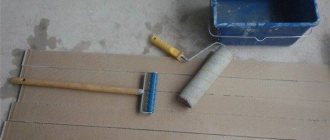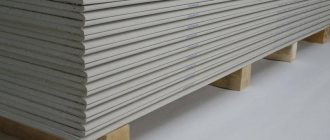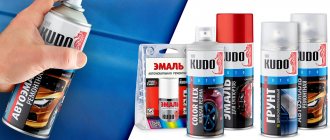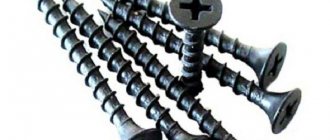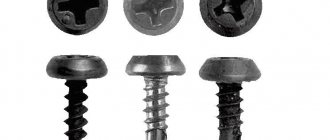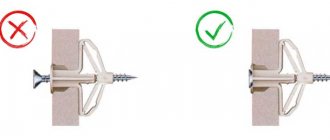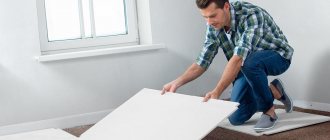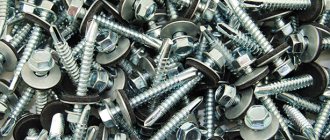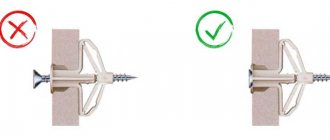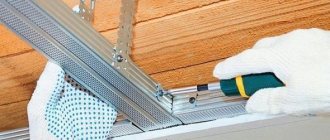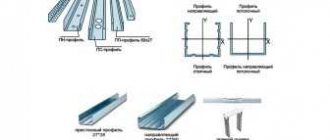When working with drywall, you can easily pinch the self-tapping screw, which causes damage to the sheets of material: cracks appear on the plaster or the cardboard ruptures on the outside. In some cases, the cap may go right through the gypsum board, and as a result the sheet will not be pressed against the profile. In any case, due to pinching, the entire structure noticeably loses strength and reliability. A drywall bit with a stopper will avoid these problems.
Models suitable for working with drywall
When assembling plasterboard structures, the following types of screws are used:
| Self-tapping screws, photo: | Description: |
Oxidized self-tapping screw 3.5*25 mm
LN 9 mm (bugs)
Galvanized self-tapping screw with press washer
All of the screws listed above go under cross bits, and if the latter are used more often with conventional models of nozzles, then for the former, mainly special ones are used, although there are exceptions.
The attachments for these screws come in different shapes and different sizes. The most common types are PZ and PH - the difference between them is the shape of the spline faces.
- For a PZ type head, all edges are strictly parallel. This allows you to accurately center the screw when screwing it in.
Bit PZ 2
- In PH-type nozzles, the slots are slightly deviated from the parallel position, which is convenient for centering even when tightening the screw at an angle. Another advantage is that when pulled, the bit pops out of the screw head without damaging it.
PH bit
In addition to the shape of the slots, the nozzles also differ in head size. No. 2 is suitable for all types of screws listed. If you determine the best bit for drywall, it will be PH 2.
Drywall screwdriver bits
PZ (Pozidriv) bits are made with strictly parallel edges. This shape guarantees retention in the screw head under any tightening forces. Visually, these types can be distinguished by the presence of additional protrusions between the edges or small recesses on the head of the screws at an angle of 45 degrees with respect to the main splines. The slight non-parallelism of the PH (Philips) slots is designed so that, with a certain force when tightening, the edges are pushed out of the screw head.
This shape promotes self-centering of the tool in the slots of the head, even when the tool is at a certain angle. Drywall screwdriver bits are produced exclusively by PH. As stated above, the bit size is 2. Thus, the inscription on the tool should be PH2. As a rule, those devices that come with a screwdriver are of rather low quality and serve only to familiarize yourself with the capabilities of the tool. All quality add-ons must be purchased separately.
For working with a screwdriver, various devices are produced, which differ not only in geometric dimensions, but also in the shape of the splines. The most common are bits with edges of the RN and PZ types. The untrained eye will not see much difference in them, except for the additional protrusions on the tool marked PZ.
The difference lies in the geometry of the splines. The bit for a drywall screwdriver has slot planes at a slight angle to each other. For PZ they are strictly parallel.
Types of nozzles
In the photos above you can see the classic version of the bit. Almost no one uses it when working with drywall, because it is easy to over-tighten the hardware. The fact is that the main strength of a plasterboard sheet is created by the paper layer. The gypsum itself is fragile and crumbles under any impact.
How does self-tapping screw fixation occur? When tightened, the tip of the fastener destroys the structure of the gypsum and pushes it apart, compressing it. Then he reaches out, the cap presses the cardboard on top, further compacting the material inside the sheet, around itself. The cap is immersed in the paper by 1-2 mm, this allows it not to break through, due to this a reliable fixation point is obtained.
Properly tightened self-tapping screw
If the self-tapping screw is overtightened, it will break through the cardboard and the gypsum core, which has crumbled into powder, will spill out. It makes no sense to screw anything else in here. A new attachment point is created at a distance of at least 5 cm from the breakout site.
That is why such bits are not used. Of course, you can get used to it, but the lack of control over the depth of immersion of the self-tapping screw is fraught with under-twisting, which greatly complicates the puttying process.
- Simplify the process of screwing in self-tapping screws with stops. They are clamped in the tool chuck, and fasteners are also manually put on them. During operation, the edge of the limiter rests against the drywall, preventing over-twisting or under-tightening.
Screwdriver attachment for drywall installation
- The limiter is a steel cartridge firmly fixed to the rod of the product. Its presence does not complicate the work in any way, except for those moments when you need to quickly move on to manipulating the screws on the frame - you have to change the attachment to a classic bit.
- The use of such a device definitely speeds up the work. It feels like no less than 20-30 percent.
Such bits are used with cordless and corded screwdrivers, chambered for different types of cartridges. The easiest way is to insert them into quick-release chucks. The speed of working with drywall is generally quite low, since you constantly have to take screws, put them on the bit, and then screw them in.
Cordless screwdriver
Professional craftsmen use them in extreme cases - when the main equipment fails.
- The photo shows a special screwdriver for drywall. Simple bits are used together with it. The limitation is set due to the shape of the cartridge. The peculiarity of the tool is that you can independently set the immersion depth of the fasteners. In fact, this option is not much different from a simple screwdriver used in conjunction with a bit with a limiter.
Drywall screwdriver
- All previous solutions seem like toys compared to a belt screwdriver - it takes 1-2 seconds to tighten one screw with this tool, while the others take at least 10. Imagine what a big difference this is in the time spent on work.
Read also: How to install an electric starter on a gas generator
Self-tapping machine gun
- Such attachments can be sold separately for certain tool models, or come as a single device. In the first case, the consumer receives more versatility, and in the second, reliability.
- To work with such a tool, special clips are sold, loaded with self-tapping screws of the required length. Wrapping occurs after pressing the trigger and pressing the tool until it stops on the sheet.
- These screwdrivers have very powerful and high-speed motors - the self-tapping screw literally flies into the material. You don’t need to hold, attach, or adjust anything - just have time to change the tape on time.
Of course, self-tapping screws in tapes are more expensive than piece ones, but remember that on a large object you can gain 1-2 days at a speed; time is also money.
Incorrect bit selection
We have already partially described the dangers of using the wrong tool. Let's continue the list.
Incredible power in your hands
Bits are made from different alloys, and their quality varies significantly from manufacturer to manufacturer. If the material turns out to be too soft, the product will fail very quickly, so buy materials only from trusted companies. The wrong shape of the splines will also cause trouble:
- The bit will constantly pop out of the screw heads, knocking down its thread.
- There will be an unreasonably high rate of wear on the bit itself;
- Jumping of the tool can result in injury and damage to the drywall surface.
- In exceptional situations, even a screwdriver can be damaged.
To prevent anything like this from happening, we follow a few simple rules:
- The bit is selected for the screws, but not vice versa.
- Ask for the PH 2 bit, as its shape is ideal for 3.5 mm self-tapping screws.
- A PZ bit is better suited for eight-point self-tapping screws.
- Make sure the bits are properly magnetized. This will help to avoid regular falling of self-tapping screws during work.
- On good bits, the slots are grooved. This allows you to improve the quality of the coupling with a self-tapping screw.
High quality bits from Bosch
- It is also important to choose the length of the nozzle. It will be convenient to get to hard-to-reach places with a longer version.
- Now about the materials. Chrome-vanadium alloys are long-lasting and durable. Both chromium-molybdenum and tungsten-molybdenum are good. Other options will not differ in special quality - their service life is short. In addition, the strength is affected by the presence of hardening - heat treatment increases the hardness of the material.
- Pay attention to the manufacturer's company. If there are no differences on paper, goods from well-known companies will definitely be of higher quality - there is no need to be bribed by the difference in price, since it always adds up to something. In a separate chapter we will analyze the best representatives on the market.
- It is worth paying attention to the coating applied to the metal. Its quality affects the safety of the tool and its resistance to corrosion. Among the available solutions, chrome-vanadium alloy is again the leader, but keep in mind that it wears out quickly with intensive use.
Set of bits of different sizes
- More expensive solutions have titanium or titanium nitride coating. Externally, it looks like gold plating, protecting the base metal from corrosion and giving it additional strength.
- Pure tungsten coating also resists loads well, but diamond coating is the most reliable in its class. It is almost impossible to erase it when tightening the screws. After spending once, you will use it for many years, even under intense loads.
Good tool accessories cost money, but professionals choose quality because it comes back to them in the form of profit. For one-time repairs and household chores, solutions at a lower price are also quite suitable.
Bit classification
Bits are usually classified according to several criteria:
- functional features;
- material of manufacture;
- coating;
- dimensions;
- form.
Depending on the functional features, the bits are divided into 3 groups.
- Basic. Here, only one working side is structurally provided. The most common nozzle option.
- Combined. There are 2 working sides at once. Simply flip the nozzle over to use a different tip. The unused side acts as a shank.
- Special. This is the rarest option. Such bits are aimed at highly specialized types of work. They are sold individually.
As for highly specialized ones, this category usually includes the following varieties:
- for bolts and nuts;
- for drywall;
- anti-vandal;
- professional;
- forks;
- spring and magnetic.
Before moving on to the remaining classification criteria, it is worth separately considering the highly specialized bits presented.
Adapters for screwdriver
When they talk about screwdriver attachments, they don’t just mean bits. This also includes various adapters that make it easier to perform non-standard tasks.
- When the installation location of the self-tapping screw is deep in the structure, in an inaccessible place, such an extension attachment can help out. You don’t have to take it out of the instrument at all, but insert the necessary bits directly into it.
Bit extension
- When assembling complex structures near walls, it is not very convenient to reach from the side with a screwdriver. This is where the angle adapter for the screwdriver comes in handy. A transmission mechanism is installed inside it. The product has a durable cartridge, which helps provide lateral force without the risk of damage. The chuck has a high transmission torque, so it effectively maintains the speed of the screwdriver engine.
Angle adapter for screwdriver 90 degrees
- This adapter is used for the most inaccessible places, however, it is not suitable for gypsum boards, since when screwing a screw into the metal, some pressure must be applied to it, which cannot be done through a flexible adapter.
Flexible adapter
There are other adapters, but we are also not interested in them.
Standard equipment
If we talk about what bits are most often needed to equip a screwdriver, then we are talking about standard components. There are several basic bits:
- Splined. The classic option and the most versatile. Used for fasteners, the head of which has a cut for a flat-head screwdriver. They differ in the width of the tip, as well as in the depth of the cut provided.
- Cross. Such nozzles have 4 ribs. Replaces a Phillips screwdriver.
- Hexagonal. Suitable for screws with an internal hexagon. Such a bat will certainly come in handy during the process of assembling or disassembling furniture.
- Under nuts and bolts. There is already an external hexagon here. The bits are characterized by increased load-bearing capacity. But they are not always included in the standard set. This is rather a highly specialized group, if you look at it objectively.
- Under the stars. They are often used in car repair and maintenance, since most of the fastenings on cars are made with a Torx key. That is, under an asterisk.
If you need to choose a suitable bit for self-tapping screws to equip a screwdriver chuck, then a standard Phillips bit will be sufficient. For other types of work and fastenings, highly specialized elements may be required.
Manufacturers of quality attachments
In this chapter, we will look at brands that provide superior quality products.
| Hardened metal screw and small thread pitch. The sheets of plasterboard themselves are attached to them to the metal frame (read our article about the types of screws for profiles under plasterboard). | |
| Needed to connect frame parts to each other. | |
| This fastening option can replace the previous one and is used for the same purposes. | |
| Manufacturer, photo: | Description: |
Milwaukee
Read also: Bits for keyless chuck
The bits from this company are considered number 1 in the world, including in our country. All models in this series are torsion bar and perfectly withstand shock loads. The material from which the nozzles are made can withstand high heat without being damaged for many years.
Dewalt
The screwdriver belt attachments from this company are also of high quality. The dcf6201 model has many positive reviews from experts.
Viha Max Thor
Tape attachment for Makita drywall screwdriver
Among other well-known companies, we also note Bosch and Hilti. Especially the second option. The tools of this manufacturer and their accessories are aimed at professional use. They serve for a long time, the work is done efficiently.
What bit is used for drywall screws?
Length of screws. From the shortest 11mm, the so-called seeds, they got their name because of their small size, about the size of a sunflower seed, to the longest 200mm. You need to select a self-tapping screw so that the connection of the parts is tight. For example, if you are fastening two 50mm bars, take a self-tapping screw with a length of at least 75mm, 90mm is possible. They allow you to fasten sheet metal up to 0.9mm without drilling a hole.
Also suitable for fastening wood. The large cap allows you to press the material being fixed more tightly and serves as a washer. They have a diameter of 4.2mm, length from the shortest to 13mm, to the longest to 64mm. Size range from 6mm-13mm. There are magnetic ones, there are simple ones, of course it is more convenient to work with a magnet, the screw does not fall out, their cost is about 1.5 times higher than regular ones.
These can be used to fasten metal up to 2mm, without drilling a hole. There is a drill at the end; it seems to drill a hole for itself and screw it in. For these you will need PH bit No. 2. As a rule, they have a frequent pitch, the distance between the threads is very small, unlike wood screws. Frequent steps are required for dense materials to ensure reliable adhesion. Black screws for metal have a diameter of 3.5 mm. If you are screwing thin sheet metal, you don’t need to pre-drill it. If the thickness of the workpiece is 2mm or more, you need to make a hole of approximately 2.8-3mm. They have PH connector No. 2.
Summing up
The screwdriver attachment for installing drywall is an important part of professional work. Focus on the information provided and you won’t go wrong in your choice.
When installing plasterboard sheets (GKL), you can easily damage the product by accidentally squeezing the screw. As a result, cracks form in the body of the gypsum, weakening it, or damage to the top layer of cardboard occurs. Sometimes the head of the self-tapping screw goes right through the gypsum board, as a result of which the sheet is not fixed to the metal profile in any way.
In any of these cases, the consequence of pinching is a loss of strength, and therefore the durability of the structure. And only a bit with a limiter for drywall will help prevent such problems.
Dimensional characteristics
In terms of size, the nozzles differ in such parameters as length, width and thickness of the slot. Each parameter has its own range:
- In terms of length, bits from 25 to 90 mm are mainly used;
- popular widths from 2 to 9 mm;
- thickness usually varies from 0.3 to 1.6 mm.
Here you need to start from what kind of fastenings you have to work with. The best solution is to buy a set or separately several different bits that can cope with various tasks.
Peculiarities
A bit with a limiter for installing gypsum plasterboards is a special type of attachment that prevents the self-tapping screw from damaging the gypsum board when tightened with a drill or screwdriver. The limiter resembles a cup, the dimensions of which are larger than the head of the bit. When twisted, the protective element rests against the sheet and does not allow the cap to penetrate the body of the gypsum board. Thanks to this limiter, the master does not have to worry about overtightening the self-tapping screw.
There is no need to tighten the fastener additionally, since a bit with a stopper allows you to firmly insert all the screws into the sheet and screw them in to the desired level.
Work with the use of a nozzle with a limiting element is significantly accelerated, since there is no need to waste time on constantly checking the quality of fasteners. The only thing that is needed is minimal experience and skills in working with the tool, because it is impossible to screw in self-tapping screws with your own hands: for this you need to use a drill or screwdriver.
You should be aware that limit bits are manufactured for different types of materials , and this is indicated by the markings on the product. If work is carried out with gypsum board, then the nozzle must be chosen specifically for this type of building material, otherwise the likelihood that the sheet will be damaged increases significantly.
You also need to ensure that the markings on the bit and the screw head match. Otherwise, the work will be inconvenient, and screws, attachments, and even electrical appliances may be damaged.
When working with drywall, you can damage the sheet, which leads to the formation of cracks and rupture of the material on the back side. To eliminate such a defect during operation, use a screwdriver with a bit that has a limiter.
Drywall screwdriver bits: bits with limiter
Depth limiting bits are available for a variety of material types. When purchasing, you need to pay attention to the labeling. The nozzle must be designed specifically for drywall, otherwise there is a risk that the material will be damaged. You also need to pay attention to ensuring that the markings of the bit and the heads of the screws match. Otherwise, the work will be uncomfortable, and the risk of damage to the screws, attachments, and even the power tool itself will increase.
Nozzles marked PH 2 are suitable for standard black self-tapping screws for drywall with a diameter of 3.5 mm, the head of which has a cross-shaped slot. Additional coatings increase the service life of the product: nickel protects against corrosion, titanium protects against various mechanical damage, diamond coating makes the bit wear-resistant, and tungsten and carbide add strength.
- Regardless of the force value set on the screwdriver, the risk of the plasterboard passing through is reduced. This is especially important for novice craftsmen who are not yet accustomed to the tool and do not know what force is enough to tightly tighten the screws, and what will be excessive.
When working with drywall, you can easily pinch the self-tapping screw, which causes damage to the sheets of material: cracks appear on the plaster or the cardboard ruptures on the outside. In some cases, the cap may go right through the gypsum board, and as a result the sheet will not be pressed against the profile. In any case, due to pinching, the entire structure noticeably loses strength and reliability.
A drywall bit with a stopper will avoid these problems.
Purpose
A bit with a limiter for drywall is nothing more than a special attachment for a drill. It is designed specifically for gypsum boards , during screwing into which the limiter rests against the surface. In this case, the self-tapping screw is recessed to the required amount. Each fastener is tightened in this way, preventing the screw from falling below the specified level.
Excessive indentation of fasteners causes unreliable fastening of plasterboard to the surface.
However, such nozzles have different spline shapes, which affects the purpose of the bits. Externally, the bat has a hexagonal shape up to 5 cm long . One side of it is attached to a screwdriver, and the other side is similar to screwdrivers of various kinds and has a bowl-shaped element. It resembles a cruciform variety. It is used to install or remove threaded connections.
Some varieties, in addition to the limiter, may have a magnetic holder. This eliminates the need for the technician to hold the fastener in his hand. High-quality fastening of self-tapping screws using a bit allows you to recess them 11 mm deep into the sheet material . However, the screw-in depth for such attachments is different. For this reason, the issue of choosing a bit should be approached thoroughly.
Read also: Homemade sharpener from a washing machine engine
Bits with limiter for mounting plasterboard sheets
When screwing in self-tapping screws, you can easily damage the plasterboard sheet. As a result, cracks appear in it or the cardboard breaks on the opposite side. The hat can pass through the gypsum board. To avoid such problems, use special bits.
What are they and why are they needed?
This is an accessory that is installed in the chuck of a screwdriver, electric drill or electric screwdriver. It is used to install or remove threaded connections (screws, self-tapping screws and other fasteners).
The bit with a limiter is designed specifically for working with gypsum boards. It prevents pinching while twisting. At the top of the equipment there is an element resembling a bowl. It is otherwise called a restrictive skirt. It is this that prevents the screw from going too deep. As a result, its cap becomes flush with the surface of the drywall. The shape of the head is specially created so that the grip is maximum and the load is distributed evenly. The fastener is tightened to the required level. This saves a lot of time, since you don’t have to be distracted by checking every screw.
Advantages and disadvantages
Using a simple attachment makes it easier to work with gypsum boards. It is made from different materials, which leads to different service life. Despite the possibility of using such attachments for a drill, it is advisable to focus on a screwdriver. It has lower speeds, so it will not spoil the gypsum board.
A bat is a necessary thing for work, through which:
- the speed and quality of work performed increases;
- the reliability of fastening the gypsum board to the base increases;
- the risk of damage to the plasterboard sheet is reduced;
- it is possible to get rid of the pimples of the base due to protruding caps;
- high-quality work with a large volume of gypsum boards is possible.
However, not every type of bit meets the stated requirements. The disadvantage of some budget varieties is their limited validity period . For this reason, one nozzle may not be enough for installation work. However, according to experts, this is not always justified.
Professional craftsmen believe that the durability of a bit with a limiter depends on the skills of working with it. If the master works correctly, then it will serve for a long time.
Other disadvantages include the lack of limiter adjustment in budget models. An analogue for professionals allows you to independently set the required length for working with different sections of the plasterboard base.
Purpose and use of drywall bits
The cost of the bit is dictated by these listed conditions. The price for a professional set starts from 2000 rubles. In this case, you need to pay attention to the manufacturer; if you often work with plasterboard structures, then it is better to give preference to well-known brands. For single jobs, you can buy 1-2 high-quality bits, the price of which starts from 200 rubles.
To prevent the bit from cutting off the notch of the screw heads, you can purchase a version with a release coupling. This attachment wraps the bit only until the stopper touches the surface of the sheet. After which the clutch is disconnected and the bit stops rotating. To solve the same problem, there are professional models of screwdrivers that have a similar device. Before screwing in, the bit with the self-tapping screw must be positioned strictly perpendicular to the surface of the sheet, and during operation you should not move the fasteners or make rotational movements.
This will lead to the formation of a large funnel in the drywall; this will not add quality to the fastening, and the cost of putty for drywall will increase. The same applies to distortions; there is no need to continue screwing in the screw; if it is distorted, it is better to unscrew it and move it to the side along the sheet. Video review of bits for installing drywall.
- The choice is made depending on the type of fastening material. If the heads have an eight-point slot (a cross groove with additional notches between them), you need to buy a bit marked PZ.
- A required parameter is the length of the fixture. It all depends on the conditions under which you will have to work. When assembling wall structures in a room, you do not need long cue balls. But in hard-to-reach places, for example, when assembling a niche made of plasterboard, and gypsum plasterboard partitions with shelves, you may need a device that allows you to reach the attachment point.
The presence of a limiter is important especially for beginners who cannot correctly assess the quality of the fastening. The design of the nozzle is very simple. It consists of a cross-shaped working part, which protrudes from the limiter to a certain distance.
Subtleties of choice
If you buy the first thing on the store shelf, you can ruin the whole job. An incorrect selection may cause damage to the screw. In addition, cuts on the head can damage the device.
It is worth considering the main nuances of selecting a bit with a limiter for drywall:
- An auxiliary attachment for a screwdriver is purchased only after purchasing self-tapping screws. The type of bit depends on them.
- At the time of selection, it is worth examining the markings of the bit. It should indicate that it is suitable for gypsum boards.
- The markings on the fasteners and the required attachment are always identical. It’s worth buying both screws and a bit at once. This is usually marked PH2.
- The most common type of cap corresponds to a diameter of 3.5 mm. The bat is chosen based on this.
- Product length may vary. You need to buy the option that is suitable for a specific base. A short bit is suitable for walls; a long bit is suitable for hard-to-reach areas and corners.
- Varieties made from chromium and vanadium, chromium and molybdenum have good recommendations. There are masters and options made of molybdenum and tungsten.
- It is worth choosing a model with a magnetic holder. You need to lower the bat into a handful of screws. If 3 elements remain on it when picked up, it is worthy of purchase.
- You need to be vigilant when purchasing. Cheap Chinese counterfeits are often sold under quality products. As a rule, they fail after screwing in several screws.
- The nozzle coating must be nickel plated. This will ensure the bit is protected from corrosion.
- In order not to suffer during the work process, it is recommended to take a professional version of the nozzle. It has a release clutch and adjustable stopper length.
- It is worth focusing on the cost and one-time nature of the work. If the tool will be used frequently, you should buy a professional version (from 2 thousand rubles). If the work is one-time, a couple of standard products (from 100 rubles) are enough, since one may not be enough.
Nuances of use and tips for choosing
Before purchasing, you need to carefully check the markings of the equipment. It should indicate that it is intended for drywall. It is also necessary to pay attention to ensuring that the markings on the elements and bits match. It is best to purchase self-tapping screws with a cross-head slot and a diameter of 3.5 mm, the bit marking is PH2. If the heads have an eight-point slot, then you should choose another bit - the PZ standard.
The length of the bit depends on the purpose of use. If you need to install gypsum boards on only one wall, then it is enough to buy a short piece of equipment with a limiter. To tighten screws in corners, under shelves and in other hard-to-reach places, it is better to purchase a longer bit.
The service life of the nozzle depends on the material from which it is made. Professional builders speak well of equipment made from the following alloys:
- chromium and vanadium;
- chromium and molybdenum;
- tungsten and molybdenum.
Very often there are fakes brought from China. For one-time and short-term use, you can buy something at a low cost.
For convenience, some bits, in addition to the limiter, have a magnetic holder, thanks to which the fasteners do not need to be held in your hand. To check the quality of this part, the bit is lowered into a handful of screws. After lifting, at least three elements should remain on it.
You should buy a bit for plasterboard boards only after purchasing self-tapping screws. Equipment is selected for fasteners, and not vice versa.
To increase service life, various protective layers are applied:
- The nickel coating will prevent the alloy from rusting.
- Diamond coating increases wear resistance.
- Tungsten carbide layer increases strength.
- Titanium coating protects against damage.
In addition to helping to speed up the work process and improve structural strength, the bat has other benefits. The risk of going through the sheet is negligible. This feature is especially convenient for those who are using such equipment for the first time, since they do not know how hard to press on a drill or screwdriver. All screws are at the same level. As a result, it will be convenient to cover with finishing materials, since nothing sticks out and there are no large depressions.
Even high-quality attachments have a low cost - in the range of 200-220 rubles. For example, Skrab 43695, 50 mm long, costs 210. The bat is made of stainless tool steel, heat-treated, and also coated with an anti-corrosion layer. Gross, 50 mm long, is made from an alloy of molybdenum and chromium, equipped with a magnetic holder, the cost is 220 rubles.
Which is better: heated floors or radiators?
Warm floorBatteries
Minimal tool skills required. Before you start repairing and fastening, it is best to practice well on unnecessary building materials. This equipment is completely worth the money spent on it, since you don’t have to waste time, effort and money on installing new sheets to replace damaged ones. Bits with a restrictive skirt can also be used for soft wood, chipboard and fiberboard.
Classification by shape
You have already learned about what basic and specialized bits there are for installation in a screwdriver chuck, and you have studied their names.
But there are a number of additional bits that differ in their non-standard shape:
- square head;
- Robertson slot (square);
- hex head;
- hex spline (Allen);
- protected hexagon slot (pin-in-hex);
- regular Torx slot (TX, T);
- Torx protected (TR);
- Tri-wing;
- Torq-set;
- Snake-eye;
- Triple Square;
- Polydrive;
- One-Way;
- 12-sided star;
- 8-sided star;
- Bristol spline;
- Pentalobular.
Of course, they are used much less frequently than standard forms of hexagon sockets. But in certain situations they can become indispensable.
So the set is selected based on what type of activity the person has and for what purposes the screwdriver will be used.
